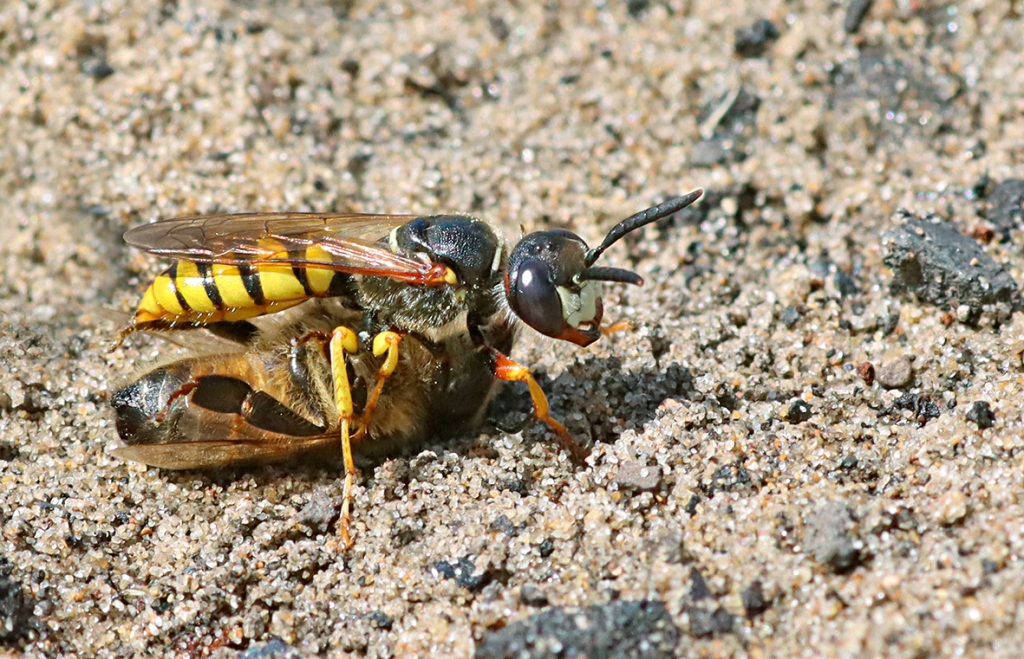The recent chatter to encourage more bee hives in our cities is somewhat alarming to me. I wouldn’t want to be a honey bee – spawned from a hybrid queen sent in the post, brought up to live a life of domesticated soviet-style drudgery, drugged up to the wing tips on pesticides, plagued by viruses and under attack from mites and fungus, worked too hard, often on a monoculture diet, continuously smoked out of their homes to have the fruits of their labour wrenched out beneath them, then left in the winter with barely enough food to eat. All in the name of having something sweet to spread on our morning toast. No wonder they are such moody insects and no wonder their colonies are collapsing.

A honey bee having a rest from the drudgery of hive life
I am being cynical. Of course honey bees are important. ‘The economic value of honey bees, and bumblebees, [note the add on and why not just ‘bees’] as pollinators of commercially grown insect pollinated crops in the UK has been estimated at over £200 million per year’. (The British Bee Keepers Association). All well and good but I see there is no mention of the other economy – the sale of honey – which I see as a bigger problem and rarely seems to be included in statistics. And we are being misled – honey bees only pollinate 30% of our crops. Which leaves me to wonder why we need them in our cities? The only ‘crops’ we have in cities are allotments and orchards and pollination of these is easily done by our other pollinators – solitary bees, wasps, flies, hoverflies, beetles, bugs, butterflies and moths. And its these we need to be focussing our energy on.

Mason bee Heriades truncorum collecting pollen
Research has shown honey bees maybe infecting bumblebees with diseases, but we don’t yet know what the effect of honey bees have on our other solitary bees. Viruses and mites brought in by honey bees, often imported, surely must have an impact, as well as the pesticides to control these. Much is made of colony collapse but how long before we see a collapse of all our insect societies due to measures taken to preserve the lives of honey bees. Less hives, especially in cities where habitat is at a premium, would allow our native bees to flourish and restore their populations which are on the decline. But we need varied and healthy habitats to ensure the survival of all our insects, not just bees. To consider preserving and encouraging the plants that naturally occur in an area – local planting feeds the local insects. Even the current trend for wildflower meadows in parks to ‘attract pollinators’, though commendable, is rather worthless if stuck in the middle of a large swathe of lawn with no shade or allowance for nesting habitats. They are also costly and time-consuming to manage. Far better to distribute those wildflowers amongst other planting, or scatter a few seeds next to a wall. Or even just ‘let it go wild’! The area left unmown in Warwick Gardens is a good example of allowing the natural growth of local plants – after 3 years we are seeing crops of clover and mallow flourish, creating a carpet perfect for grasshoppers to hide in and flowers for hoverflies and butterflies to feed on. The yarrow, loved by beetles, has also expanded its range. Yes sometimes we do need to manage it but at a much lower level – pulling up the odd fat-hen plant that has run riot is maybe not a bad thing! We often forget we have to allow for some of our pollinators that feed on other insects and this is rarely mentioned in plans when considering planting. Some solitary wasps stock up on sap-sucking shield bugs and aphids to feed their young, and the inclusion of plants and grasses to accommodate these is vital. Meanwhile, all these insects will be pollinating the beans and peas you are growing on your allotment.

Thick-legged beetle Oedemera nobilis covered in yarrow pollen
So why do we need hives in our cities? Education? Studies of beekeeping for ‘unruly’ kids has benefits, especially around respect and responsibility. I can’t argue with that but a big part of me would prefer to promote the life of our solitary bees. Watching mason bees and leafcutter bees building their nests in a bee hotel is not only fun, it also teaches us important lessons about the fragility of life. Solitary bees have to defend themselves against cuckoo bees and parasitic wasps without the back-up of an all-stinging all-waggle dancing army. Their life is harder and more hit and miss. All the more reason to treasure them.
And the other reason for hives? Honey. Honey should be a speciality food, like truffles, expensive and hard to come by. I worry that the current trend for all things ‘olde and crafty’ will see a rise of pop-up hives, hipster honey and mead. The air in our city is pretty grim so I can almost see a diesel flavoured honey appearing on the shelves, along side a bottle of mead with a ‘hint of carbon monoxide’. And all the while the poor little honey bee is working itself to death to put that sugar hit on your toast. Harsh, I know. But ideally I would put a ban on hives altogether until the honey bee has had a chance to recover, and allow our other pollinators to take the credit for all the hard work they do.












